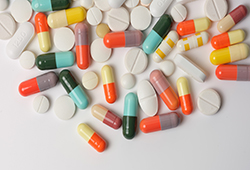 Idenix’s Pharmaceuticals’ patent (U.S. Patent No. 7,608,597) was invalidated for having a genus that was “too broad.” The trial judge ruled that the patent did not enable a person of skill in the art to select a single compound from the “billions and billions” of compounds encompassed by the genus. On appeal, the Federal Circuit upheld the trial judge’s ruling of non-enablement. On January 19, 2021, the Supreme Court of the United States (SCOTUS) declined to review the Federal Circuit’s decision to invalidate Idenix’s patent.
Idenix’s Pharmaceuticals’ patent (U.S. Patent No. 7,608,597) was invalidated for having a genus that was “too broad.” The trial judge ruled that the patent did not enable a person of skill in the art to select a single compound from the “billions and billions” of compounds encompassed by the genus. On appeal, the Federal Circuit upheld the trial judge’s ruling of non-enablement. On January 19, 2021, the Supreme Court of the United States (SCOTUS) declined to review the Federal Circuit’s decision to invalidate Idenix’s patent.
This decision is likely to have effects across the pharmaceutical and biotech field. The Federal Circuit’s ruling may narrow the scope of generic protection granted to pharmaceutical companies for novel drug scaffolds. Chemical genus claims are often used to deter “fast followers” from making small modifications to a drug’s design to avoid patent coverage. In their amici briefs, both GlaxoSmithKline and Amgen argued that this narrowing would result in a decrease in innovation across the pharmaceutical space.
Idenix’s patent claimed a method of treating Hepatitis C virus (HCV) infection by administering a class of synthetic nucleosides, β-D-2′-methylribofuranosyl nucleosides, also known as a “2’-methyl-up nucleosides”. Idenix’s patent covered any 2′-methyl-up nucleoside which fell within the claimed chemical genus that was effective in treating HCV. Idenix sued Gilead Sciences, alleging the ‘597 patent’s claimed genus encompassed the compound sofosbuvir, an active ingredient in Gilead’s hepatitis C drugs Sovaldi and Harvonis. In 2016, a Delaware jury agreed and awarded Idenix $2.5 billion. However, the district judge set aside the jury’s verdict, ruling the patent was invalid on enablement grounds. The judge contended this genus was too broad, and the patent did not enable a person of skill in the art to select a single compound from the “billions and billions” of compounds encompassed by the genus.
On appeal, the Federal Circuit determined the patent did not provide “meaningful guidance” or “useful blaze marks” to direct a person of skill to specific effective hepatitis C therapeutics within the claimed genus. That a person of ordinary skill in the art would not know, without undue experimentation, which 2′- methyl-up nucleosides would be effective for treating HCV. The court concluded that the working examples present in the patent were “very narrow, despite the wide breadth of the claims at issue” and were insufficient to enable such a broad genus.
Merck & Co. acquired Idenix Pharmaceuticals for $3.85 billion in 2014.
 Canadian Patent Examination
Canadian Patent Examination
 The FDA’s Center for Drug Evaluation and Research (CDER) approved 50 new drugs and biological products in 2021 (not including the vaccines, cellular and gene therapy products, or other products approved in 2021 by the Center for Biologics Evaluation and Research). As in past years, small molecule drug approvals dominated the list.
The FDA’s Center for Drug Evaluation and Research (CDER) approved 50 new drugs and biological products in 2021 (not including the vaccines, cellular and gene therapy products, or other products approved in 2021 by the Center for Biologics Evaluation and Research). As in past years, small molecule drug approvals dominated the list. Idenix’s Pharmaceuticals’ patent (U.S. Patent No. 7,608,597) was invalidated for having a genus that was “too broad.” The trial judge ruled that the patent did not enable a person of skill in the art to select a single compound from the “billions and billions” of compounds encompassed by the genus. On appeal, the Federal Circuit upheld the trial judge’s ruling of non-enablement. On January 19, 2021, the Supreme Court of the United States (SCOTUS) declined to review the Federal Circuit’s decision to invalidate Idenix’s patent.
Idenix’s Pharmaceuticals’ patent (U.S. Patent No. 7,608,597) was invalidated for having a genus that was “too broad.” The trial judge ruled that the patent did not enable a person of skill in the art to select a single compound from the “billions and billions” of compounds encompassed by the genus. On appeal, the Federal Circuit upheld the trial judge’s ruling of non-enablement. On January 19, 2021, the Supreme Court of the United States (SCOTUS) declined to review the Federal Circuit’s decision to invalidate Idenix’s patent.
 When submitting a new drug application (“NDA”) with the FDA, an applicant (or branded company) is required to file a list of patents that cover the drug product. These patents will be listed in the FDA’s Orange Book upon approval of the drug for commercial sale. Patents that are eligible to be listed in the Orange Book are patents that have claims that cover the drug substance (active ingredient), the drug product (formulation and composition), or the approved method of use.
When submitting a new drug application (“NDA”) with the FDA, an applicant (or branded company) is required to file a list of patents that cover the drug product. These patents will be listed in the FDA’s Orange Book upon approval of the drug for commercial sale. Patents that are eligible to be listed in the Orange Book are patents that have claims that cover the drug substance (active ingredient), the drug product (formulation and composition), or the approved method of use.

 Life science companies developing new therapeutics – both small molecule and biologic – know that obtaining long patent term for their products is a key driver of valuation and revenue. A particular challenge in this respect is minimizing the loss of patent term during drug development. Fierce competition in the marketplace often requires that innovators patent their drug products as early as possible in the development process, but because the clock on a United States (patent’s lifespan starts running the moment it is filed, years of valuable patent term are often lost as a product navigates the regulatory approval process. An important method to mitigate these losses can be found in the Patent Term Extension (“PTE”) provisions of 35 U.S.C § 156, which provide statutory compensation for the substantial time and resources expended by an innovator to bring a new drug to market. In a nutshell, PTE restores a portion of the patent term, up to five years, that is lost during the period a new drug or medicinal product is awaiting pre-market regulatory approval in the U.S.. When a new chemical entity (“NCE”) – either a small molecule or a biologic – is approved by FDA as a therapeutic, a patent claiming either the NCE or its method of use may be entitled to PTE.
Life science companies developing new therapeutics – both small molecule and biologic – know that obtaining long patent term for their products is a key driver of valuation and revenue. A particular challenge in this respect is minimizing the loss of patent term during drug development. Fierce competition in the marketplace often requires that innovators patent their drug products as early as possible in the development process, but because the clock on a United States (patent’s lifespan starts running the moment it is filed, years of valuable patent term are often lost as a product navigates the regulatory approval process. An important method to mitigate these losses can be found in the Patent Term Extension (“PTE”) provisions of 35 U.S.C § 156, which provide statutory compensation for the substantial time and resources expended by an innovator to bring a new drug to market. In a nutshell, PTE restores a portion of the patent term, up to five years, that is lost during the period a new drug or medicinal product is awaiting pre-market regulatory approval in the U.S.. When a new chemical entity (“NCE”) – either a small molecule or a biologic – is approved by FDA as a therapeutic, a patent claiming either the NCE or its method of use may be entitled to PTE.